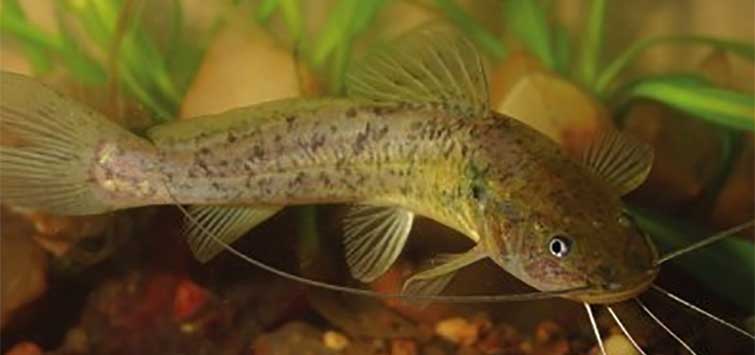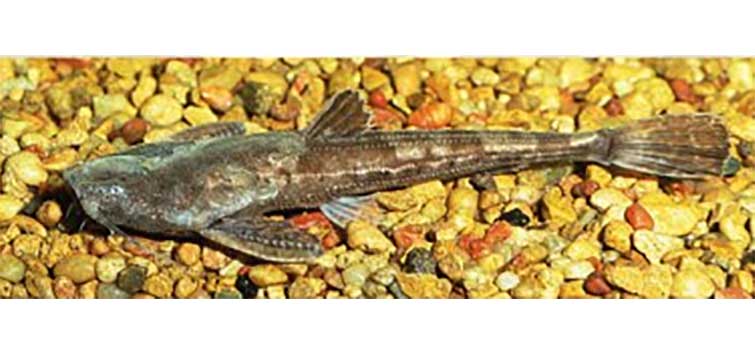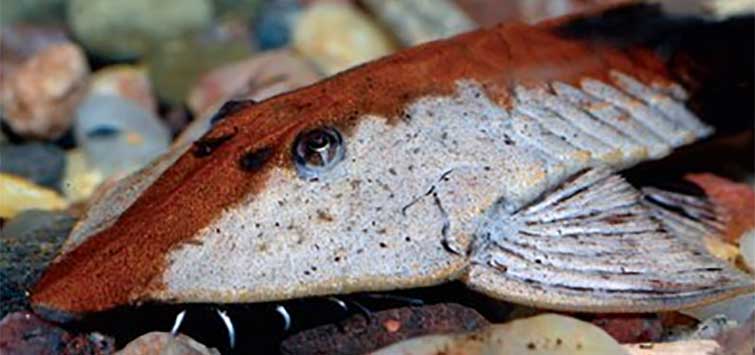Catfish Corner: Random Notes
Author: Lee Finley
“POW!”
I would like to start off with a brief mention of a recently described Otocinclus catfish (“oto cat”) from Colombia and Peru. While it is generally similar in overall morphology to the commonly seen imports, it is very different in its caudal fin pattern and species name. The new species is named Otocinclus batmani in honor of the comic book hero Batman. The species name refers “…to the single W—or bat-shaped vertical spot on the caudal-fin.” This is seen to its best when the fish is in a head-up position. Although the origin of Batman is in the comics, if anyone sees Messieurs West, Keaton, Kilmer, Clooney, or Bale, please let them know just in case. They might be proud.
In a recent post on PlanetCatfish, Erwin Schraml (catfish photographer extraordinaire!) stated that in reviewing back over his photographs of Otocinclus he was able to show that this species had been imported into Germany as far back as 2001. It might well have also made it into the United States at some time, but I am unaware of any photographs that might confirm this.
Stressing Out?
Stress is something we all live with, and our captive catfishes are no different. If we can keep them happy, and accordingly stress free (or at least at lower stress levels), it also makes things a little easier on ourselves.
Many things may induce stress in our catfishes. Smacking into their tank immediately comes to mind, but of course there are many other factors. Just confinement itself can be a major stressor for many catfishes. There is a good body of literature building up with studies of the South American tropical catfish species Rhamdia quelen, which is a popular food fish and is subjected to extensive aquaculture work. Although physicological responses to stress can be expected to vary greatly among so large a group as the catfishes, it is nice to have a somewhat smaller tropical species to provide a guideline of sorts. There is similar work ongoing with a number of other catfish families (e.g., Pangasiidae, Clariidae), and work in this area may also be able to offer useful help to the aquarist.
For these notes here I would like to make mention of two recent studies performed with Rhamdia quelenas the test subject.
The First Study
The first study explored the effect of the color spectrum of lighting and how it acted on the stress response of the tested fishes. I remember seeing, years ago, a television program on how various colors affected stress. Although no catfishes were used, there was a segment that covered how clown loaches responded to various background colors on their tank. As I recall, blue was very good and red was not so. This information is good to keep generally in the back of the mind.
For the study under consideration as it relates to illumination, juvenile Rhamdia were conditioned in three separate aquaria with aeration, water changes, and good feeding taking place. Afterwards, these groups were divided and in different aquaria were set up with different fluorescent lighting for a period of 10 days. The lighting that was used included:
· Super white light
· Coral blue light
· Aquarium green light
For 10 days all fish were carefully maintained and provided with a photoperiod of 12 hours of light and 12 hours of darkness. At the end of the 10 days, a group of the fish were subjected to stress (others, a control group, were left alone). Just noting the stressing method that was performed for the study potentially offers a good hint to aquarists. The stressor used was simply chasing the fish around the tank for a period of 60 seconds! This is something well worth keeping in mind when netting your catfishes.
I won’t go too deeply into what testing went on from there, but it basically consisted of taking the fish, obtaining blood from them, and testing it for cortisol levels. Cortisol is a natural steroid produced by the adrenal glands at times of stress (for fish and humans alike).
The basic results at it relates to the illumination under which the various groups of fish were maintained are as follows (these are based on cortisol blood levels):
1. Fish maintained under green light showed the highest reaction to stress.
2. Fish kept under a white light showed the lowest reaction.
3. Fish under blue light were also low in stress reaction, although slightly higher than the white-light group.
But, when each group was compared with their control group, the overall best results as relates to lack of stress was observed in the blue-light group. This is interesting in that the manufacturer of the lights used in the study does state that their blue light is recommended for catfish.
Although I couldn’t find too much information on green spectrum fluorescent lighting, maybe this is a good thing, as this study shows—at least in Rhamdia—that it should be avoided. Standard white spectrum lights are, of course, widely used in freshwater aquaria, but blue spectrum lights are used less so. In fact, the general advertisements for them are mainly aimed at the marine hobby. So maybe it is time for catfish keepers to look into those bulbs and see how it affects the general welfare of catfishes. It certainly sounds promising for raising young catfish, and I would assume that similar results could also be expected with adults.
The authors do note that young Rhamdia kept and raised mostly in the dark generally do much better than those raised under lights. But aquaculturists, like aquarists, do have to deal with reality and need to find the best illumination—for both themselves and their fishes.
The Second Study
The next study, also involving Rhamdia quelen, deals with the potential problems of young fish exposed to different dissolved oxygen levels.
In standard aquaria, problems with low levels of dissolved oxygen are rarely a problem. But with raising young fish and the usually associated heavier feeding to promote growth, problems can arise. In this study, not only did having the fish at low oxygen levels create problems, but the moving of them to water with higher oxygen levels also created problems (albeit temporary ones).
Young Rhamdia maintained in water with low oxygen levels are reported to experience low growth rates. This certainly underscores the importance of maintaining adequate oxygen levels. Problems can develop when young fish are transferred to tanks with differing levels of oxygen. This includes both greater and lower levels. The problems that occur involve the osmoregulatory system of the fishes, and some of the problems encountered include lower ammonia excretion and imbalances in blood electrolytes (sodium, chloride, and potassium).
While these changes appear to be reversible by improving the oxygen environment, the fish are nonetheless exposed to stress during the change-over period. Such fluxes are best avoided whenever possible. From an aquarium standpoint, which is usually not as population intensive as that seen in food-based aquaculture, it would be ideal to concentrate on keeping potentially contributing factors (food buildup, too many fish in a smaller tank) to a minimum while doing regular but small water changes on a frequent basis. Less stress = better and faster growth.
Corydoras sp. “Black”
While I am mainly more of a paper person (and will no doubt stay so), I do appreciate the importance of the Internet and have a few websites that I regularly visit. One of these is petfrd.com. While this site sub-bills itself as the “Singapore Cichlid Community,” its scope is far ranging beyond just this popular group of aquarium fishes. The section of importance here is that which deals with catfishes.
Recently the topic of the so-called Corydoras sp. “black” came up. The thread was a discussion involving a species known under the trade name Corydoras sp. “Venezuela black” and was originated by Karel Zahradka of the Czech Republic. A catfish e-friend who frequents the site, Yann Fulliquet, was involved in the discussion and had contacted Hans-Georg Evers regarding the fish and he received a gracious reply. I will note here that I have had the pleasure to be able to meet Hans-Georg and he is a fine person and filled to the brim with all kinds of catfish knowledge. In any case, his reply was posted on the site and he noted “…please spread the story to avoid further rumours…” So with this in mind I will offer a paraphrase of the information provided by him. I offer my thanks for his making this material available, and note all credit due to him.
Before presenting the information, I will note that Evers and Ian Fuller, in their 2005 book Identifying Corydoradinae Catfish, do make note of the catfish under discussion and identify it as “Corydoras aeneus black breeding form.” It is briefly noted to be “…produced in the aquarium.”
Now to the post. Evers states that the “black aeneus” was first produced some years back by Hartmut Eberhardt of Weimar, Germany. The first “black aeneus” were sports produced among normal-colored babies of a Corydoras schultzei type fish (C. schultzei is currently considered a synonym of C. aeneus).
In the first few months of their life these dark sports have orange fins. Now, as it happens, there is also a wild Corydoras aeneus type that is found in the Llanos of Venezuela and Colombia, and this fish is exported to the hobby. This fish also has orangish fins, but the body is lighter in color. Evers notes that when this fish is stressed the body color takes on a darker complexion and that they do resemble the tank-created “black aeneus.” He goes on to suggest that this is where the name “Venezuela black aeneus” has its origin.
Again, thanks to Hans-Georg for providing this information and to Yann for making it generally available.
References
Barcellos, L. J. G., et al. 2006. “The color of illumination affects the stress response of jundiÁ (Rhamdia quelen, Quoy & Gaimard, Heptapteridae).” CiÊncia Rural. 36(4):1249–1252.
de Rosso, F. L., et al. 2006. “Ion fluxes in silver catfish (Rhamdia quelen) juveniles exposed to different dissolved oxygen levels.” Neotropical Ichthyology. 4(4):435–440.
Lehmann, P. 2006. “Otocinclus batmani, a new species of hypoptopomatine catfish (Siluriformes:Loricariidae) from Colombia and Peru.” Neotropical Ichthyology. 4(4):379–383.

.png?h=595&iar=0&w=2781&hash=5FD5E69473BCC22199FBFA2FB71B6033)



